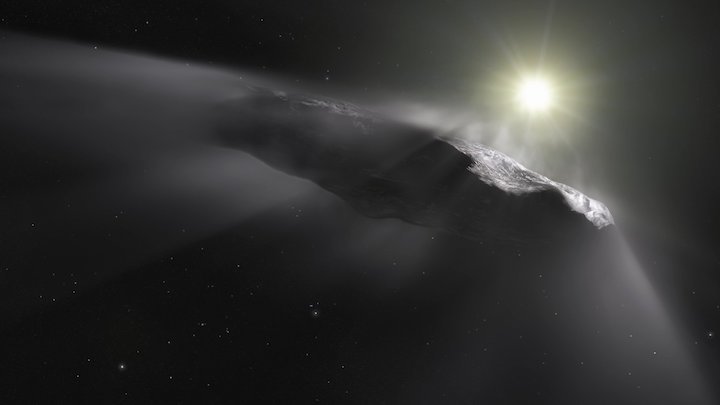6.12.2018

Credit: NASA/ESA
If the first interstellar object ever detected in our solar system is actually an alien spacecraft, it's operating in stealth mode.
A search for radio signals coming from 'Oumuamua, the mysterious visitor from afar that zoomed through the inner solar system last fall, came up empty, a new study reports.
"We were looking for a signal that would prove that this object incorporates some technology — that it was of artificial origin," study lead author Gerry Harp, of the SETI (Search for Extraterrestrial Intelligence) Institute in Mountain View, California, said in a statement. ['Oumuamua: Our 1st Interstellar Visitor Explained in Photos]
"We didn't find any such emissions, despite a quite sensitive search," Harp added. "While our observations don't conclusively rule out a non-natural origin for 'Oumuamua, they constitute important data in accessing its likely makeup."
Harp and his colleagues used the SETI Institute's Allen Telescope Array (ATA), a system of 42 radio dishes in Northern California, to listen for possible 'Oumuamua signals from Nov. 23 to Dec. 5 of last year. At the time, the bizarre cigar-shaped object was about 170 million miles (275 million kilometers) from Earth — nearly twice the distance from our planet to the sun.
The team listened for pings with a frequency between 1 and 10 gigahertz, with a resolution of 100 kilohertz. The observation campaign was capable of picking up signals produced by an omnidirectional transmitter with a power between 30 and 300 milliwatts, the researchers said.
"In all cases, these limits to the powers that could be detected are quite modest — comparable to that of cell phones or citizen band radios," SETI Institute representatives wrote in the same statement.
Harp and his team weren't the only group to eavesdrop on 'Oumuamua last fall. The $100 million Breakthrough Listen project also tried its hand, using the Robert C. Byrd Green Bank Telescope in West Virginia. That search turned up nothing as well.
SETI scientists are so interested in 'Oumuamua because of the object's provenance and weirdness. 'Oumuamua is an oddly tumbling, needle-shaped body that's likely about six times longer than it is wide. And, during its cruise through Earth's neighborhood late last year, it displayed nongravitational acceleration — movement that cannot be attributed to the tugs of the sun, planets or other objects.
The leading explanation holds that 'Oumuamua is an alien comet, and the odd movement was the result of outgassing. (When comets get close to the sun and heat up, jets often erupt from their icy surfaces; such jets can act like little thrusters, pushing the bodies this way and that.)
But some scientists have speculated that 'Oumuamua might be a spacecraft of some sort, perhaps a reconnaissance probe tasked with checking out our neck of the cosmic woods. Harvard astronomers Shmuel Bialy and Avi Loeb laid out such a case recently, positing that 'Oumuamua could be a "sailcraft" pushed along by starlight.
Sadly, such speculation about 'Oumuamua's may reign forever. The object fled beyond the reach of our most powerful telescopes long ago, so we'll probably never get another look at it.
The new study will be published in the February 2019 issue of the journal Acta Astronautica.
Quelle: SC
